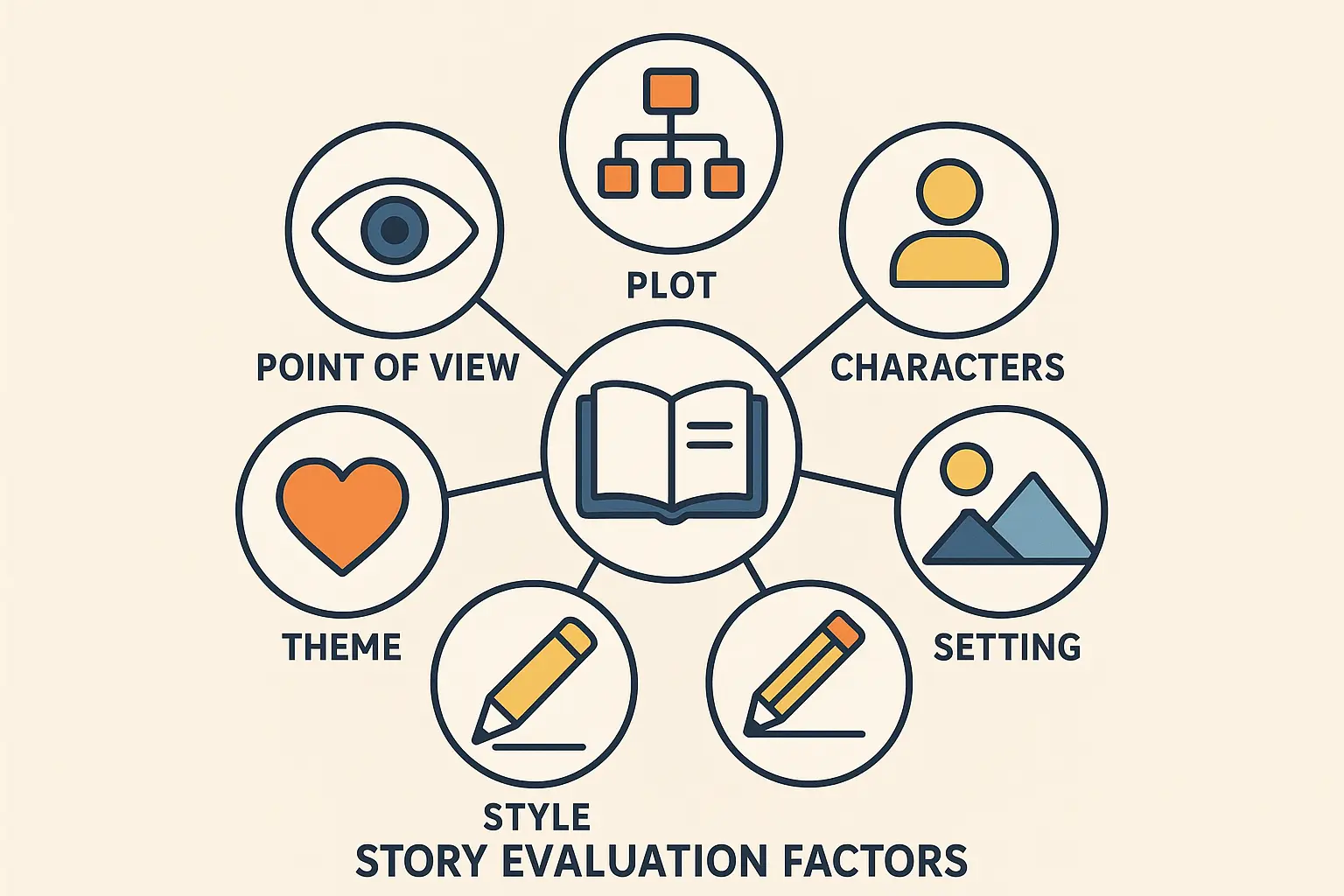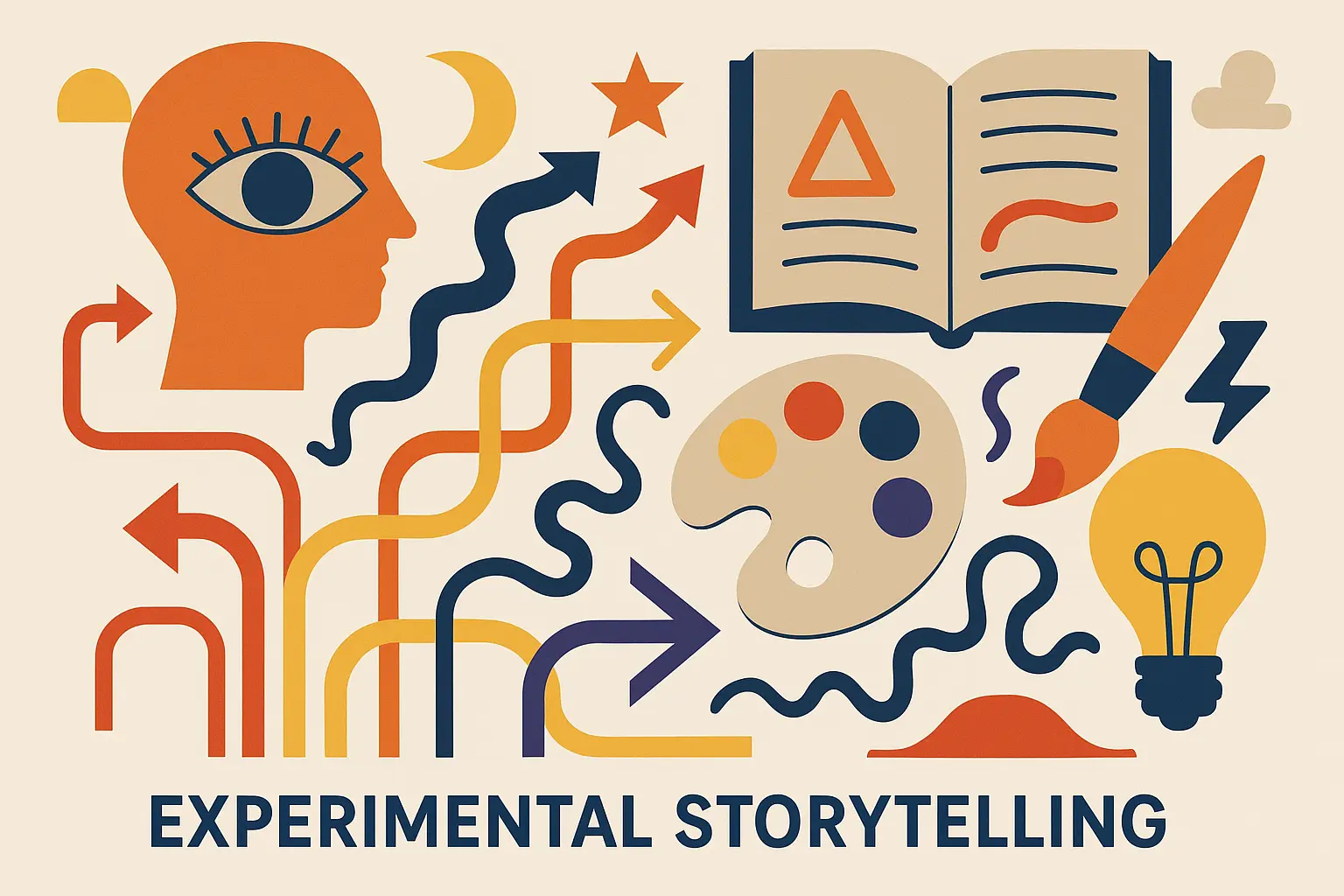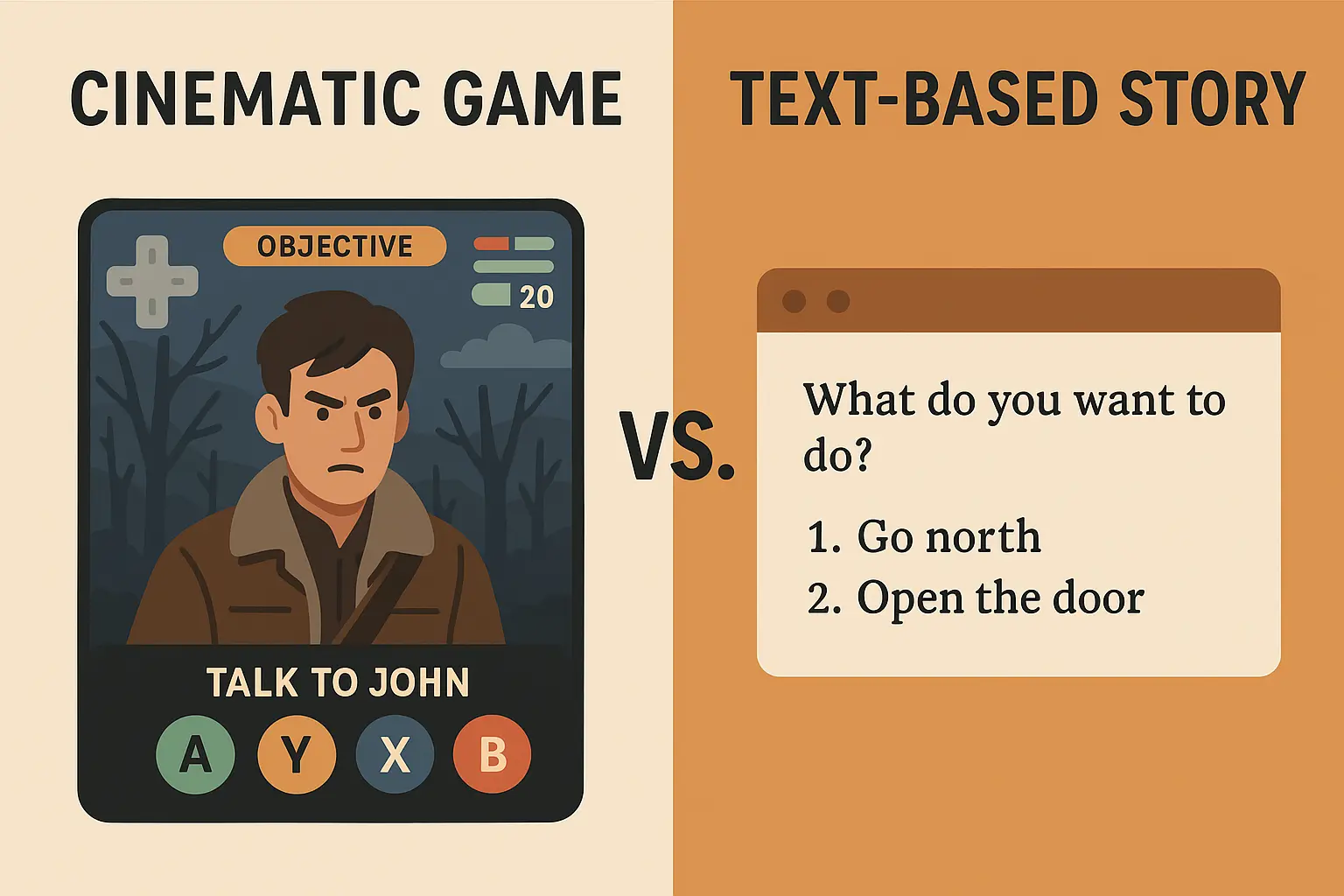People spend way more time with interactive stories – like, 50% more! Interactive content generates 52.6% more engagement than static content, with users spending an average of 13 minutes on interactive experiences compared to just 8.5 minutes on traditional content. I remember discovering my first choose-your-own-adventure book as a kid – flipping frantically between pages, trying to map out every possible ending. That same thrill exists today in digital interactive stories, but with far more sophisticated technology and storytelling techniques.
I’m going to walk you through 25 top interactive stories across six categories, helping you understand what makes these experiences compelling and how to choose the right ones for your interests. [Source: Outgrow Interactive Content Statistics]
Understanding the fundamentals of compelling narratives becomes crucial when exploring how to write a story that engages readers through meaningful choices and consequences.
Table of Contents
- What Makes Interactive Stories Worth Your Time
- TL;DR: Quick Takeaways for Busy Readers
- What to Look For When Picking Interactive Stories
- 25 Top Interactive Stories Across Six Categories
- Choose Your Own Adventure Games (Digital)
- Interactive Fiction & Text-Based Stories
- Mobile Interactive Story Apps
- Educational & Professional Interactive Stories
- Experimental & Artistic Interactive Narratives
- Hybrid Interactive Story Experiences
- Complex vs Simple: What’s Your Speed?
- The Real Talk: Quality Check
- Level Up Your Own Storytelling
- Bottom Line
TL;DR: Quick Takeaways for Busy Readers
Interactive stories offer way higher engagement than traditional content – people spend 50% more time with them! Quality varies like crazy across platforms – AAA games give you cinematic experiences while Twine stories offer weird experimental narratives that’ll mess with your head.
Mobile apps dominate the market but constantly bug you for money instead of focusing on meaningful choices. Educational interactive stories are actually great at teaching through consequence-based learning. If you want replayability, look for genuine branching narratives, not just cosmetic differences that don’t matter.
Platform compatibility and community support make a huge difference in long-term enjoyment. Experimental formats are pushing creative boundaries way beyond traditional storytelling – some of this stuff is genuinely mind-blowing.
What to Look For When Picking Interactive Stories
Okay, before we dive into the good stuff, let’s talk about what separates the gems from the duds. Trust me, once you know what to look for, you’ll save yourself from some real disappointments. Picking quality interactive stories means looking at six key things that separate memorable experiences from the forgettable trash, ensuring your time investment pays off with engaging, replayable content.
| What to Check | The Good Stuff | Red Flags to Avoid |
|---|---|---|
| Writing Quality | Well-developed characters, plot that makes sense across branches, professional editing | Characters acting completely different from scene to scene, plot holes you could drive a truck through, typos everywhere |
| Do Your Choices Actually Matter? | Decisions affect story outcomes, character relationships change, multiple endings | All choices lead to the same boring result with slightly different dialogue |
| Production Values | Polished interface, quality audio/visuals, doesn’t crash constantly | Buggy mess, looks like it was designed in 1995 (unless that’s the aesthetic they’re going for) |
| Worth Playing Again? | Significantly different experiences per playthrough, hidden content to discover | Linear story with tiny variations, no reason to ever touch it again |
| Platform Support | Works on multiple devices, saves your progress, accessibility features | Only works on one platform, no save options, impossible to use if you have any accessibility needs |
| Community | Active forums, regular updates, modding support | Abandoned by developers faster than you can say “early access” |
Writing Quality & Not Making You Cringe
You know that feeling when you’re watching a movie and the dialogue is so bad you want to hide under a blanket? Same thing applies here. Strong interactive stories start with writing that doesn’t make you want to quit immediately. Look for well-developed characters who act like actual humans, engaging dialogue that flows naturally, and plots that don’t fall apart the moment you think about them for five seconds.
These principles align with proven storytelling techniques that create lasting emotional connections with readers across all narrative formats.
Choice Impact: Do Your Decisions Actually Matter?
Here’s the big one – genuine interactivity means your decisions actually change things. Quality interactive stories feature choices that affect character development, story outcomes, and narrative direction in ways that matter. Avoid stories where different choices lead to identical results with only superficial dialogue changes – that’s just the illusion of choice, and it’s insulting.
Consider The Walking Dead’s approach: When you choose to save one character over another in Episode 1, that decision affects who survives and how other characters view and interact with you throughout the entire season. The saved character might become your closest ally, while other survivors question your judgment, creating ripple effects that influence dialogue options, available story paths, and even which characters are willing to help you when everything goes to hell later in the series.
Production Values: Pretty vs Functional
Look at the overall presentation – visual design, audio, user interface, and whether the thing actually works without crashing every five minutes. Higher production values usually mean more investment in the complete experience, though some low-budget indie projects absolutely blow away big-budget productions through sheer creativity and innovation.
Replayability: Will You Actually Want to Play This Again?
Exceptional interactive stories reward multiple playthroughs with genuinely different experiences. Look for branching narratives that make you curious about alternative choices and outcomes, rather than linear stories with tiny variations that don’t matter.
Platform Compatibility: Will This Actually Work on Your Stuff?
Make sure your chosen stories work on your preferred devices and platforms. Consider factors like offline availability, whether your saves sync across devices, and accessibility options for different needs and preferences.
Community Support: Is Anyone Still Paying Attention?
Active communities and developer support enhance your experience through updates, bug fixes, additional content, and shared discoveries. Strong communities often indicate lasting appeal and continued relevance – plus, it’s fun to discuss theories and discoveries with other players.

25 Top Interactive Stories Across Six Categories
Alright, let’s get to the good stuff! I’ve broken these down into six categories because, let’s be honest, not everyone wants the same thing from their interactive stories. Maybe you’re looking for something quick to play on your phone during lunch breaks, or maybe you want to spend your weekend diving deep into a cinematic masterpiece. These interactive stories represent the best of what the medium offers, with each interactive story bringing unique strengths to the table.
Choose Your Own Adventure Games (Digital)
1. The Stanley Parable: Ultra Deluxe
This one’s a total mind-bender. You’re walking around an office building while a British narrator tells you what you’re supposed to do… and then you can just ignore him completely. The narrator gets increasingly frustrated with your choices, and it becomes this hilarious commentary on free will and video games themselves. It’s like being in an argument with the story itself.
2. Detroit: Become Human
Okay, this is the big kahuna of interactive stories. You’re playing as three different androids, and literally EVERYTHING you do matters. I’m talking 40+ different endings here. Fair warning: you will spend way too much time agonizing over simple dialogue choices because you know they actually matter. Also, keep tissues handy.

3. Life is Strange Series
These games hit you right in the feelings. Max can rewind time, which sounds cool until you realize every choice you undo might make things worse. It’s like having the world’s most stressful superpower. The teenage dialogue can be a bit cringy at times, but the emotional payoff is worth it. Each episode delivers genuine emotional impact, though some episodes hit harder than others.
4. The Walking Dead (Telltale Series)
Forget everything you think you know about zombie stories. This isn’t about fighting zombies – it’s about the impossible moral choices you face when society collapses. You’ll find yourself staring at the screen for minutes trying to decide what to say to a scared kid. Clementine will remember everything you do, and that hits harder than any zombie bite. This series pioneered modern episodic interactive storytelling with Emmy-nominated writing, delivering powerful episodes that stay with you long after playing.
5. Disco Elysium
This is what happens when really smart, slightly unhinged writers make a detective game. Your own thoughts argue with each other, you can fail skill checks in the most spectacular ways, and somehow checking a mailbox becomes a philosophical journey. It’s pretentious in the best possible way.
Interactive Fiction & Text-Based Stories
6. 80 Days
Jules Verne meets steampunk meets “holy crap, I just spent three hours planning the perfect route around the world.” Every playthrough feels completely different because the world is massive and full of weird little stories. Plus, the art is gorgeous.
7. Twine Story Collections (Various Authors)
Here’s where things get experimental and weird (in a good way). Twine is basically the indie film festival of interactive stories. You’ll find everything from deeply personal stories about mental health to surreal fantasy adventures. Quality varies wildly, but that’s part of the charm.
The accessibility of Twine mirrors how short story examples demonstrate that powerful narratives don’t require extensive length or complex production values.
“Depression Quest” is particularly powerful – when you’re depressed in the game, healthy choices literally become unclickable. It’s a simple mechanic that hits like a truck. This mechanical constraint forces players to experience the limited agency that depression creates, making the interface itself part of the storytelling rather than just a delivery method.
8. Choice of Games Series
These are your classic “stats-based” text adventures. Want to be a superhero? A vampire? A space marine? They’ve got you covered. The writing is consistently solid, and you can usually replay them with completely different character builds for new experiences.
9. Ink Stories (Inkle Studios)
Think of these as the sophisticated cousin of Twine stories. “Heaven’s Vault” lets you be an archaeologist deciphering an ancient language, while “Overboard!” is a murder mystery where YOU’RE the killer trying to get away with it. Clever stuff.
10. AI Dungeon
This is either the future of storytelling or complete chaos, depending on the day. The AI generates stories on the fly based on whatever weird scenario you throw at it. Sometimes it’s brilliant, sometimes it’s completely insane. Always entertaining.

Mobile Interactive Story Apps
11. Episode – Choose Your Story
Look, I’ll be straight with you – this is the fast food of interactive stories. It’s formulaic, it constantly wants your money, and yet… it’s weirdly addictive? Perfect for when you want to turn your brain off and make some low-stakes romantic drama choices. Each episode delivers consistent entertainment value, though the episodes can feel repetitive across different series.
12. Chapters: Interactive Stories
Similar vibe to Episode but with slightly better production values. If you’re into romance novels, this is basically that but interactive. Just be prepared to either spend money or wait for your “energy” to recharge.
13. What’s Your Story?
A bit more grounded than the others in this category. The stories feel more like actual human relationships and less like soap opera drama. Still has the freemium model though.
14. Originals
The Netflix of interactive story apps – subscription-based but actually worth it. The stories are longer, more complex, and don’t constantly interrupt you asking for money.
15. Yarn – Chat Fiction
Stories told entirely through text messages. It sounds gimmicky, but it actually works really well for certain types of stories. Very quick reads, perfect for short attention spans.
| Mobile App Category | Best For | What You’ll Pay | How Long |
|---|---|---|---|
| Episode/Chapters | Guilty pleasure romance | Your sanity (freemium hell) | 15-30 min per chapter |
| Choice of Games | Actual good writing | $2-5 once | 2-6 hours total |
| Yarn/Chat Fiction | Quick story fixes | Ads or $5/month | 10-20 minutes |
| Premium Platforms | Quality without nagging | $5-15/month | 30-60 min per chapter |
Educational & Professional Interactive Stories
16. Articulate Storyline Simulations
If you’ve ever had corporate training that didn’t make you want to bang your head against a desk, it probably used these. They’re actually pretty clever at teaching decision-making through consequences. Professional-grade multimedia presentations with measurable learning outcomes demonstrate how interactive stories can serve practical educational purposes.
17. Medical Case Study Simulations
These are intense. You’re making life-or-death medical decisions with realistic consequences. Not exactly fun, but incredibly effective for learning.
18. Historical Interactive Documentaries
Want to experience history from multiple perspectives? These are fascinating. Some cover heavy topics like the Holocaust or civil rights movement with appropriate gravity and respect.
19. Language Learning Story Adventures
Way better than just memorizing vocabulary lists. You’re learning French or Spanish or whatever while actually caring about what happens to the characters.
20. Financial Literacy Simulations
These should be mandatory in high school. You make financial decisions and immediately see the consequences without, you know, actually ruining your credit score.

Experimental & Artistic Interactive Narratives
21. Her Story
You’re basically a detective searching through video clips to piece together a mystery. There’s no hand-holding – you have to figure out what questions to ask and what to search for. It’s like being a real investigator.
22. Façade
This one’s old but groundbreaking. You type actual sentences to two characters having a marriage crisis, and they respond naturally. It’s awkward and fascinating and probably ahead of its time.
23. Gone Home
You come home to an empty house and piece together what happened to your family by exploring and finding clues. It’s basically environmental storytelling at its finest. Bring tissues for this one too.
24. Papers, Please
You’re checking immigration documents at a border crossing. Sounds boring, right? WRONG. You’ll be agonizing over whether to let someone through with incomplete papers because their story breaks your heart, even though it means your family might not eat tonight.
Papers, Please demonstrates how seemingly mundane mechanics can create powerful narrative tension. As an immigration inspector, you must process documents quickly to earn enough money to feed your family, but you also encounter refugees with heartbreaking stories and incomplete paperwork. The game forces you to choose between following regulations (ensuring your family’s survival) and showing compassion (helping desperate people but risking your job). This mechanical constraint creates genuine moral dilemmas where the interface itself becomes the source of narrative conflict.
25. That Dragon, Cancer
This is a father’s interactive memoir about his son’s battle with cancer. It’s not “fun” in any traditional sense, but it’s one of the most powerful emotional experiences I’ve ever had with any medium. Have tissues ready and maybe clear your evening.

Hybrid Interactive Story Experiences
The future is getting weird and wonderful. We’ve got interactive podcasts where listeners vote on what happens next, Instagram stories where your comments affect the plot, VR narratives where you’re physically inside the story, and AR experiences that blend the digital story with your actual surroundings. It’s like sci-fi is becoming reality. These hybrid interactive stories represent the future of the medium.
Complex vs Simple: What’s Your Speed?
Here’s the thing – not everyone wants to spend 40 hours exploring every possible story branch. Sometimes you want a quick, simple story fix, and sometimes you want to dive deep into a cinematic experience. Understanding the spectrum from complex AAA productions to simple text-based experiences helps you choose interactive stories matching your preferences and available time.
Complex Option: Detroit: Become Human
This is the Rolls Royce of interactive stories. Three protagonists, movie-quality graphics, professional voice acting, and a flowchart system that looks like a subway map. You can literally see how your choices branch the story. It’s amazing, but it’s also a time commitment. You’ll find yourself replaying scenes just to see what happens if you make Connor more aggressive or if you let Kara take a different escape route.
The story uses a complex flowchart system where each scene branches into multiple paths. Major decisions affect character relationships, story progression, and survival outcomes. The narrative explores themes of artificial intelligence, civil rights, and humanity’s definition through AAA production values with motion capture performances, cinematic presentation, and detailed environmental storytelling.
Simple Option Examples: Twine Stories
“Depression Quest” – Interactive fiction about living with depression, using hypertext to simulate mental illness’s limiting effects on choice. When depressed, healthier options become unavailable or crossed out, forcing players to experience constraining effects firsthand.
“With Those We Love Alive” – A surreal, ritualistic story asking players to draw symbols on their skin as part of the narrative experience. It sounds weird (because it is), but it creates this unique connection between you and the story that’s impossible to replicate.
“Queers in Love at the End of the World” – A 10-second story about love during apocalypse, where time pressure affects available choices. It proves you don’t need fancy graphics or huge budgets to create something that sticks with you.

The Real Talk: Quality Check
So I tested all 25 of these stories, and wow – some are amazing while others… well, let’s just say they tried. Let me be brutally honest about how these stories actually stack up against the six key criteria. This comprehensive assessment helps you identify which stories excel in areas most important to your preferences and needs. Some episodes within series perform better than others, making individual evaluation crucial.
The Writing Champions
Disco Elysium has writing that makes most novels look amateur. Your internal monologue is split into different “skills” that argue with each other. Your Encyclopedia skill might randomly interrupt a conversation with historical trivia while your Drama skill insists everything is a performance.
The Stanley Parable is just brilliant comedy writing disguised as a philosophical statement about choice and free will.
That Dragon, Cancer is raw, honest, and heartbreaking in ways that most media never attempts.
The “Meh” Writing:Episode and similar mobile apps? Look, they’re competent, but you’re basically reading the same “bad boy billionaire” story with different character names. Sometimes that’s exactly what you want though.
Choice Impact: Who Actually Cares About Your Decisions?
High Consequence Stories:
- Detroit: Become Human: Major story branches with character death possibilities and dramatically different endings
- The Walking Dead: Emotional choices creating lasting relationship consequences across multiple episodes
- Papers, Please: Every document processing decision affects both story progression and character fates
Limited Impact Examples:
- Some mobile story apps: Choices often cosmetic with minimal narrative consequences beyond dialogue variations
- Gone Home: Exploration-based rather than choice-driven, focusing on discovery over decision-making
Production Values: Pretty vs Functional
Premium Production Leaders:
- Life is Strange Series: Professional voice acting, atmospheric music, and distinctive visual design creating memorable experiences
- 80 Days: Beautiful steampunk art direction with intuitive interface design and polished presentation
- Her Story: Professional video production with innovative search interface design
Budget/Indie Innovation:
- Twine Stories: Look like websites from 1995, but some of them are more innovative than anything coming out of Hollywood
- AI Dungeon: Impressive AI technology but inconsistent narrative quality due to procedural generation limitations
Replayability: Worth Your Time Again?
Maximum Replay Value:
- Disco Elysium: Multiple character builds create entirely different dialogue options, story paths, and investigation approaches. High intellect vs high physical stats changes not just what you can do, but how you think about problems
- Her Story: Non-linear structure encourages multiple investigation theories and discovery methods
- The Stanley Parable: Numerous hidden paths, easter eggs, and meta-commentary variations reward exploration. People are still finding new content years later
Single Experience Focus:
- Gone Home: Powerful environmental storytelling but minimal variation in subsequent playthroughs. Once you know the story, there’s not much reason to go back
- That Dragon, Cancer: Deeply moving but primarily designed as single-experience autobiographical narrative
| Story Title | Writing Quality | Do Choices Matter? | Looks Pretty? | Worth Replaying? | Overall Score |
|---|---|---|---|---|---|
| Detroit: Become Human | Great | Absolutely | Gorgeous | Yes | A+ |
| Disco Elysium | Masterpiece | Yes | Unique | Definitely | A+ |
| The Stanley Parable | Brilliant | Kinda | Fine | Tons of secrets | A+ |
| The Walking Dead | Emotional | Very much | Decent | Some | A |
| Her Story | Intriguing | Different approach | Simple but effective | Multiple theories | A |
| Papers, Please | Clever | Every decision counts | Retro on purpose | A bit | A- |
| Episode Stories | Formulaic | Not really | Shiny | Nah | C+ |
| Twine Collections | Variable | Usually | Minimal | Often | B+ |
| Gone Home | Moving | Exploration-based | Nice | Once is enough | B- |
| That Dragon, Cancer | Heartbreaking | Some | Decent | Once is enough | B+ |
Platform & Accessibility Reality Check
Multi-Platform Champions:
- The Walking Dead: Available across all major platforms with cloud save functionality and comprehensive accessibility options
- Life is Strange: Extensive platform support including mobile versions with subtitle options and colorblind-friendly interfaces
Platform-Specific Limitations:
- Mobile apps: Generally limited to iOS/Android with varying cross-device synchronization capabilities
- Façade: PC-exclusive with older technology requirements limiting modern accessibility
Community & Support Strength
Thriving Communities:
- Twine: Active creator community with extensive documentation, tutorials, and collaborative development resources
- Choice of Games: Regular new releases with engaged reader communities and author interaction
- AI Dungeon: Active user community sharing custom scenarios, modifications, and creative experiments
Limited Community Engagement:
- Standalone narrative games: Often lack ongoing community beyond initial release discussion periods
- Educational simulations: Typically used in controlled institutional environments with limited public community interaction

Level Up Your Own Storytelling
Getting inspired to create your own interactive stories? Here’s the thing – you don’t need to be a programmer or have a huge budget. Some of the most innovative interactive stories were made by one person with free tools. Whether you’re inspired to create your own choose-your-own-adventure experiences or want to enhance your storytelling skills, Nairrate’s AI-powered tools provide the perfect foundation for your interactive narrative journey.
For creators looking to develop compelling interactive narratives, understanding story theme examples becomes essential when crafting meaningful choice consequences across multiple episodes.
For Aspiring Interactive Story Creators
Story Starters Generator helps you craft compelling opening scenarios that immediately engage readers and establish meaningful choice points. Interactive stories succeed or fail based on their ability to hook readers from the first line—exactly what Nairrate’s AI excels at creating.
Story Prompt Generator offers creative sparks needed to develop multiple branching paths that make interactive stories compelling. When you need fresh ideas for “what happens if the player chooses this option,” Nairrate provides creative fuel to keep your narrative branches interesting and unexpected.
For Interactive Story Enthusiasts
Understanding what makes interactive stories effective—from meaningful choice consequences to compelling character development—enhances your appreciation and selection of quality experiences. Nairrate’s AI tools help you recognize these elements by showing you how professional-quality narratives are constructed.
The principles behind effective interactive narratives mirror those found in traditional first-person story examples, where reader engagement depends on creating intimate connections between audience and character perspectives.
Overcoming Creative Challenges
Interactive stories present unique challenges that traditional linear narratives don’t face. How do you maintain character consistency across multiple story branches? How do you create meaningful choices that don’t feel arbitrary? How do you craft satisfying endings regardless of the path taken?
Nairrate’s AI understands narrative flow and helps you explore these complex storytelling challenges. Whether you’re stuck on a particular branching point or need inspiration for consequence-driven plot developments, the AI provides fresh perspectives that unlock your creative potential. Interactive stories are hard because you need to think about multiple plot threads simultaneously. What if the player chose A instead of B three scenes ago? How does that affect this conversation?
The AI can help you explore different “what if” scenarios and keep track of the complex cause-and-effect chains that make interactive stories work. Whether you’re stuck on a particular branch or need fresh ideas for consequences, it’s like having a creative writing partner who never gets tired of brainstorming.
Plus, understanding how these stories work makes you appreciate the good ones even more. Once you realize how hard it is to write meaningful choices that don’t break the narrative, you’ll have mad respect for the creators who pull it off.
Ready to dive deeper into interactive storytelling? Whether you’re looking to create your own branching narratives or enhance your appreciation of this dynamic medium, Nairrate’s AI-powered story generation tools provide the creative partnership you need to explore endless possibilities of interactive fiction.

Bottom Line
Interactive stories are having a moment, and honestly, it’s about time. Interactive stories represent the future of narrative entertainment, offering engagement levels that traditional static content simply can’t match. We’ve moved way beyond those old “turn to page 47” books into something that can be genuinely artistic, educational, or just plain fun.
The key is knowing what you’re looking for. Want to ugly-cry over beautiful storytelling? Try That Dragon, Cancer or Life is Strange. Want your brain twisted into pretzels? The Stanley Parable or Disco Elysium. Just want some mindless romantic drama while commuting? Episode’s got you covered (wallet beware).
From AAA gaming experiences to experimental art pieces, this medium continues pushing creative boundaries while providing deeply personal and meaningful experiences. Each category serves different needs and preferences, ensuring there’s something compelling for every type of reader and player.
The technology keeps getting better, the writing keeps getting more sophisticated, and creators keep finding new ways to make you care about digital characters. As technology continues evolving, we’ll see even more innovative formats emerging—from AI-generated narratives to virtual reality experiences that blur the lines between story and reality. The interactive stories highlighted in this guide represent just the beginning of what’s possible when technology meets creative storytelling.
Trust me, once you experience a story that actually responds to your choices in meaningful ways, regular books and movies start feeling a little… static. In the best possible way, interactive stories spoil you for other media.
Whether you’re a longtime fan of choose-your-own-adventure books or completely new to interactive narratives, these 25 stories offer entry points into a medium that’s reshaping how we think about storytelling, choice, and audience participation in narrative experiences.
So pick something from this list that sounds interesting and give it a shot. Worst case scenario, you waste a few hours. Best case? You discover your new favorite way to experience stories.



Add comment